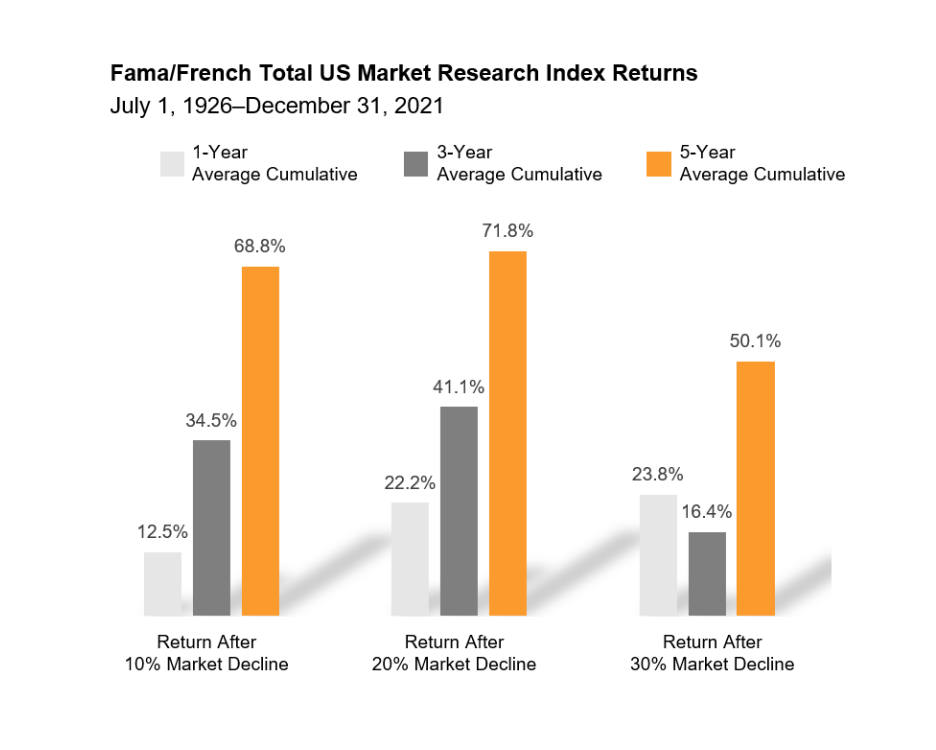
While the terms “bear market” and “recession” can apply simultaneously in times of a declining stock market and a slowing economy, each has a unique meaning and use. As explained in our article “Why Do We Refer to Markets as Bulls and Bears?”, the definition of a bear market is a decrease of at least 20% from a recent high. Although a bear market has a definable and clear checkpoint, the causes and lengths of bear markets can vary.
According to the New York Times article “Bear Markets and Recessions Happen More Often than You Think,” the U.S. stock market has been in a bear market nearly 24% of the time since 1929. While the term can provoke fear, successful investors have survived and ultimately thrived by staying put. This slide show from the New York Times highlights some of the more notable bear markets, but it’s likely that the next bear market will look different from the preceding ones. The bear market of 2020 lasted only three months while the Great Depression carried on for over 10 years, from 1929 to 1939. While there have been instances of bear markets reaching deep declines, history has proven that investors and the stock market are resilient, as shown in the illustration below.
See Graphic Notes below.
Bear markets and recessions don’t follow the same indicators and can, therefore, have different causes and outcomes. The National Bureau of Economic Research (NBER) is a private organization that investigates and analyzes major economic issues and is regarded by many in the economic community as the signal caller of whether the U.S. is in a recession. The NBER defines a recession as “a significant decline in economic activity that is spread across the economy and that lasts more than a few months.” Depth, diffusion, and duration are intentionally vague in that definition.
The 2020 recession is a perfect example of this vagueness. Even though the NBER recognized the economic downturn was not long-lasting, the economy experienced such a significant drop in activity across many factions that the length was disregarded and the NBER classified the period of February 2020 to April 2020 as a recession.
Since World War II, the United States has been in recession 14% of the time. Another interesting disparity between recessions and stock market declines appears in the illustration below.
Exhibit 2
Fret Lag
Recession announcements vs. US stock market lows

See Graphic Notes below.
Because recessions are proclaimed with a delay and not in real time, markets are often on the way toward a recovery by the time of the announcement. As shown in Exhibit 2, the stock market had already bottomed out prior to the announcement month in two-thirds of recessions since 1980. In the 2020 recession, for example, the market’s low point came in March, three months before the announcement in June 2020. The takeaway for investors? If and when a recession is declared, we think the most sensible approach is to remain disciplined; reducing exposure to stocks at that point may lead to missing out on brighter days ahead.
Understanding the history and definitions of bear markets and recessions will equip investors to make good decisions for a positive personal economic future.
Past performance is no guarantee of future results.
Figure 1 In US dollars. Recessions shaded in orange. Stock returns represented by Fama/French Total US Market Research Index, provided by Ken French and available at mba.tuck.dartmouth.edu/pages/faculty/ken.french/data_library.html. This value-weighted US market index is constructed every month, using all issues listed on the NYSE, AMEX, or Nasdaq with available outstanding shares and valid prices for that month and the month before. Exclusions: American depositary receipts. Sources: CRSP for value-weighted US market return. Rebalancing: Monthly. Dividends: Reinvested in the paying company until the portfolio is rebalanced. Growth of wealth shows the growth of a hypothetical investment of $100 in the securities in the Fama/French US Total Market Research Index from July 1926 through December 2021.
Figure 2 Prior to 1979, the NBER did not formally announce recessions. Data from “Are We Headed for a Recession?” Wes Crill, PhD, Head of Investment Strategists and Vice President of Dimensional, June 17, 2022.






